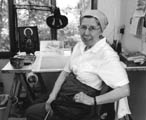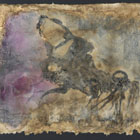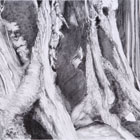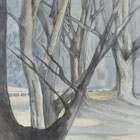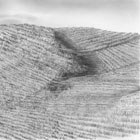JANET HART HEINICKE
artwork | audio | statement | 2008 update
artwork
see more work in Beyond 9-11: The Art of Renewal in Iowa
audio 
(see also Beyond 9-11: The Art of Renewal in Iowa)
- Drawing (59 sec. | 406KB): listen | read
- Music or art (57 sec. | 391KB): listen | read
- Family (54 sec. | 368KB): listen | read
- Need to make art (45 sec. | 305KB): listen | read
- Best moments (22 sec. | 146KB): listen | read
- Advice (60 sec. | 412KB): listen | read
artist statement
The work I create as an artist grows out of response to what I see and draw.
This response springs from a personal conviction that the physical world (that is, the world of sticks and stones, of trees, and plants, of broad rolling fields and swiftly changing clouds) is endlessly interesting. I am convinced that the natural world contains many small surprises often overlooked. "Wait a minute," I ask my viewer. "Wait, look long, and really see the infinitely interesting shapes, textures, patterns, the amazing surprises on this small planet, earth, that we share with one another!"
I "look long" at things. I probe these "few things" deeply, drawing and re-examining, drawing again, exploring differences in light and dark, smooth and rough, size and scale, trying to understand what I see. I "mine" the subject, like an excavator, for understanding, probing it to discover what its essential nature is. In a manner somewhat similar to that of the oriental artist, I look for the "essence," the "spirit" of the subject. If successful in this search, then the drawing succeeds.
Additional drawings, paintings, or small prints may evolve out of this examination and eventual understanding, generally less descriptive and more abstract.
(December 2007)
2008 update
How has your life changed since the interview?
I am probably more comfortable with the changes in lifestyle that retirement from full-time teaching and administration brought than I was initially! I found meaningful ways to continue to use my interests in people, and in creating changes in community life, whether it is statewide or local. The most important shift in my life is from making art as a means of explaining or illustrating aesthetic principles for others, to making art as a means of a much more personal expression.
What kind of artwork are you doing now?
I continue to create a lot of drawings. (In fact, at the 2007 Metro Arts Expo in Des Moines I juried in the area of "drawing" and exhibited only drawings.) Since the interview my "old" interest in printmaking revived; small monoprints, intaglio and etchings have occupied both time and interest and been a logical outgrowth of the extensive drawings. Since the interview, I had the pleasure of concentrated study in printmaking at Anderson Arts Ranch in Aspen, Colorado. Painting continues to occupy both time and interest but in terms of the development of an idea, the drawings come first and then are followed either by prints or by paintings. Both prints and paintings tend to become more abstract and "looser" than the drawings! The scale of all the work continues to shrink! The intensity of interest in surface quality and patterns continues to grow! My constant point of reference is always found in the out-of-doors.
I do school workshops every year, sometimes through Metro Arts and sometimes through other organizations. Generally, these are workshops about batik. I have for the past three years also shown batik work at the Reiman Gardens summer art show where the batik that I presented sold very well. About every other semester I teach a course in batik at the Des Moines Art Center. In June 2007, I traveled back to Tanzania for the fourth or fifth trip. There I gave batik workshops for rural farm women, teaching them a different approach to a well-known African craft in order that they might have a more marketable product and hence a cash income source.
How has your artwork changed in the last ten years?
Recently I took a piece of my own over to our church (where I arrange monthly exhibitions of art for the members of the congregation to view). It was a collaged piece made of various papers onto which I had stitched large threaded lines. (Amazingly, I have had many positive responses to this piece which is pretty abstract!) The piece I took was executed ten years ago!
What is the same about the ten-year-old collaged paper and thread piece and the pieces that are out in the studio getting worked on this week? Well, the interest in color and pattern are still there! The willingness to sacrifice recognizability for composition and design are still there. I would say I am probably a little more careful about presentation and completion, less careless about presentation. As I have tried to become "more professional" in my work so that it meets the public in more public venues this is, of course, more important. I have tried to "teach" myself how to produce work that is acceptable in a public, more commercial venue as opposed to an academic venue where experimentation is both acceptable and valued.
What motivates you to continue making art?
I think the source material for me has not changed a lot. However, as I reflect upon several one-person exhibitions mounted about 1998 and 1999, especially the "Universality" show, where the ideas undergirding the work were so important to me that sometimes the work became didactic, I know that I have changed my intent and purpose in much of what I am producing presently. In my studio I have a little quotation which I slid under the glass on the table where I work. It says something to the effect that the artist should "continue the testimony of what humans have seen, believed, felt and thought; we must have the courage to ask ourselves what we really care about....if we do not know, we cannot express it. To seek beauty and meaning in our lives is to bring it into our art." I think that now is the time to "harvest the spiritual wonder of life."
What advice do you have to give to others?
I reviewed my own advice from ten years ago, and found much of it seems real and true today! I still think artists must believe in themselves; I think that we artists indeed must have the courage to ask ourselves "what do I really care about?" I see that there is much that is wrong, much that is dark, much that could be called evil around us. But I choose to care more about the daily evidence of goodness among human beings, as it shows itself in countless "little acts of kindness"; I choose to care about the daily evidence of wonderful colors, shapes and textures that exist in the small things of the natural world. That is an intentional choice. So my advice to others is to LOOK long and hard at this wondrous place, this tiny planet, earth, where we dwell, to treasure it and its inhabitants and treat both with honor, respect, indeed with love and to choose to do so! Not by accident, but by deliberate intention, I think it is desirable to make this choice the strong foundation of what we daily make visible in our art-making, in our work.
audio text
Drawing
As a little girl I did a lot of drawing, was encouraged to do that, a lot of painting, I was encouraged to do that. I was very fortunate to go to a high school that had four galleries in it. There was a Richmond Art Association which had a permanent collection housed in galleries which were built in the high school fine arts building. So there was a fine arts building with a theater, and ensemble practice rooms for orchestra and band, and then there was an art room.
During the summers and school holidays, I went with my mother when she did her visits. When she had to make a call for a client, I sat in the car and waited. I drew on the liners of Bill Sharmeer's stocking boxes. The stockings used to come with a very nice cardboard box and there were liners between the three pairs of hosiery. Mother would give me those liners, and then I'd draw on them.
Music or art
I had extensive musical training as a child, and nearly became a music teacher. I had an organ teacher who approached her lesson-giving from the standpoint of expressiveness rather than the standpoint of accuracy or consistency with the composer's work. And that teacher gave me a very precious gift—that of loving to use that instrument as a tool for self-expression. It was a different way for me to look at art or music.
I was thinking about music as a career and thinking about art as a career, and my mother said to me, "What do you like to do best? Choose the thing you really like to do." Well, it's as simple as I just like to make things. I like making things! Well, as soon as I could identify that, then the rest of those choices became clear.
Family
I am absolutely convinced that having a family of more than one made me a much more flexible person. I think had I not married or had children, I would have been a very rigid kind of human being, because I do organize things well, and I like to have things in a sort of orderly sequence of events. So I'm sure I have become a more flexible, more empathetic person with other human beings than I ever would have been without children. Now possibly that makes me more willing to be flexible in the way I approach my work. I don't feel any qualms about moving from one media to another or from one content area to another—that is okay as far as I'm concerned, and I don't feel like I'm being untrue to myself when I do that.
Need to make art
I need to make art. As much as anything, it's a necessity for me to be whole. So I probably will always make art, because this is something I must do. And I can tell when I don't; I'm not as happy. And if it goes too long without making art, I begin to think I have all kinds of imaginary illnesses. Of course, I don't have any of them; I just need to be in the studio. Working in my studio is joy for me; it's just pure joy.
Almost as much as I love making art, I love teaching. So that I gain something; the students feed me with their spirit or their simplicity or their need.
Best moments
I do like making things, so the process is fun for me. I think the very best moments in the studio are those moments when you've lost yourself in the act of making it—when the piece begins to talk back to you, and you listen and hear it. Those are the very best moments.
Advice
Believe in yourself. And if this is something you love to do, that's what's really important. Students are flocking into the graphic design area, because they feel that they can get a job there—not, is this something they have any passion about? I think it is the loving to do it, the passion about it, that sustains you through the tough times. I think without that, all you have is a job. And in today's work world, a job is not going to sustain you through the ups and downs of employment. It's the passion that will.
I try to encourage women and girls to think about the necessity to encourage women in the arts. There is a kind of commitment that is necessary in art, as there is in every profession. I think those of us who are older women have an obligation to encourage that commitment.

